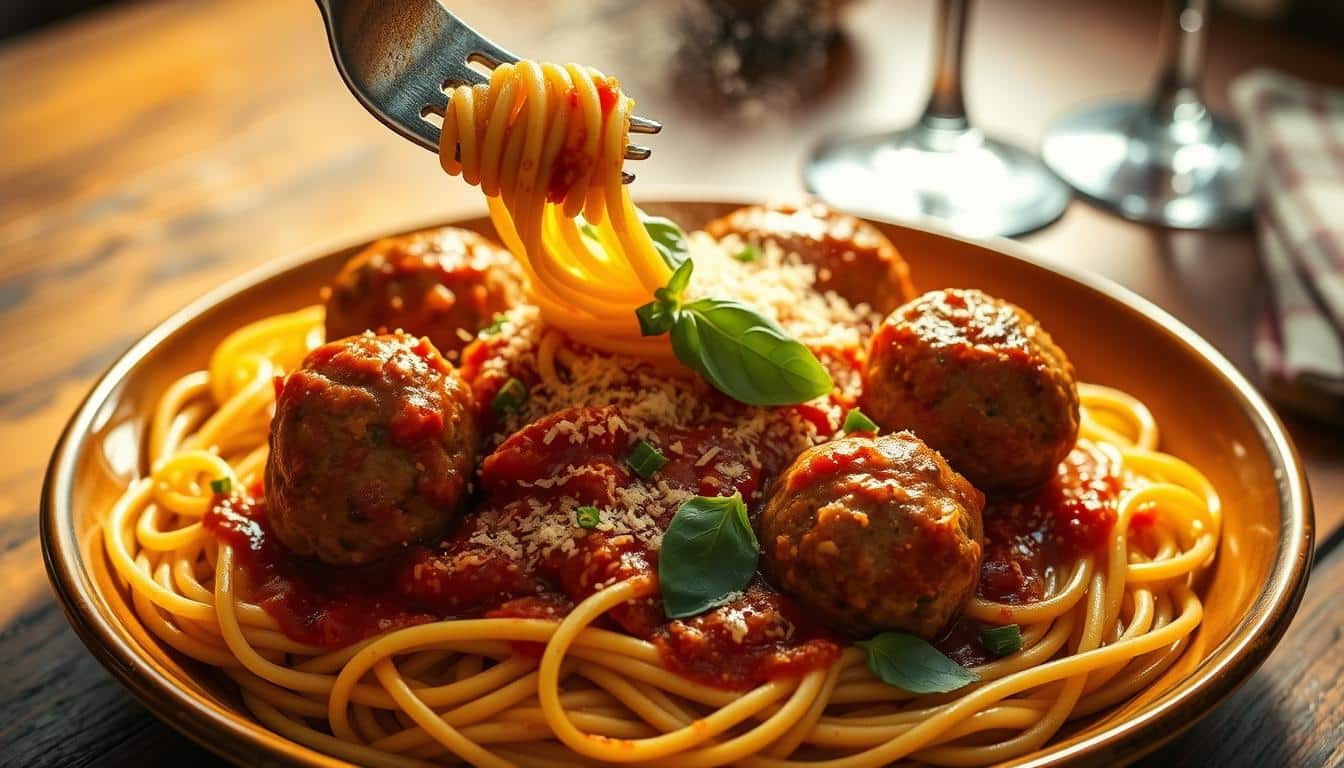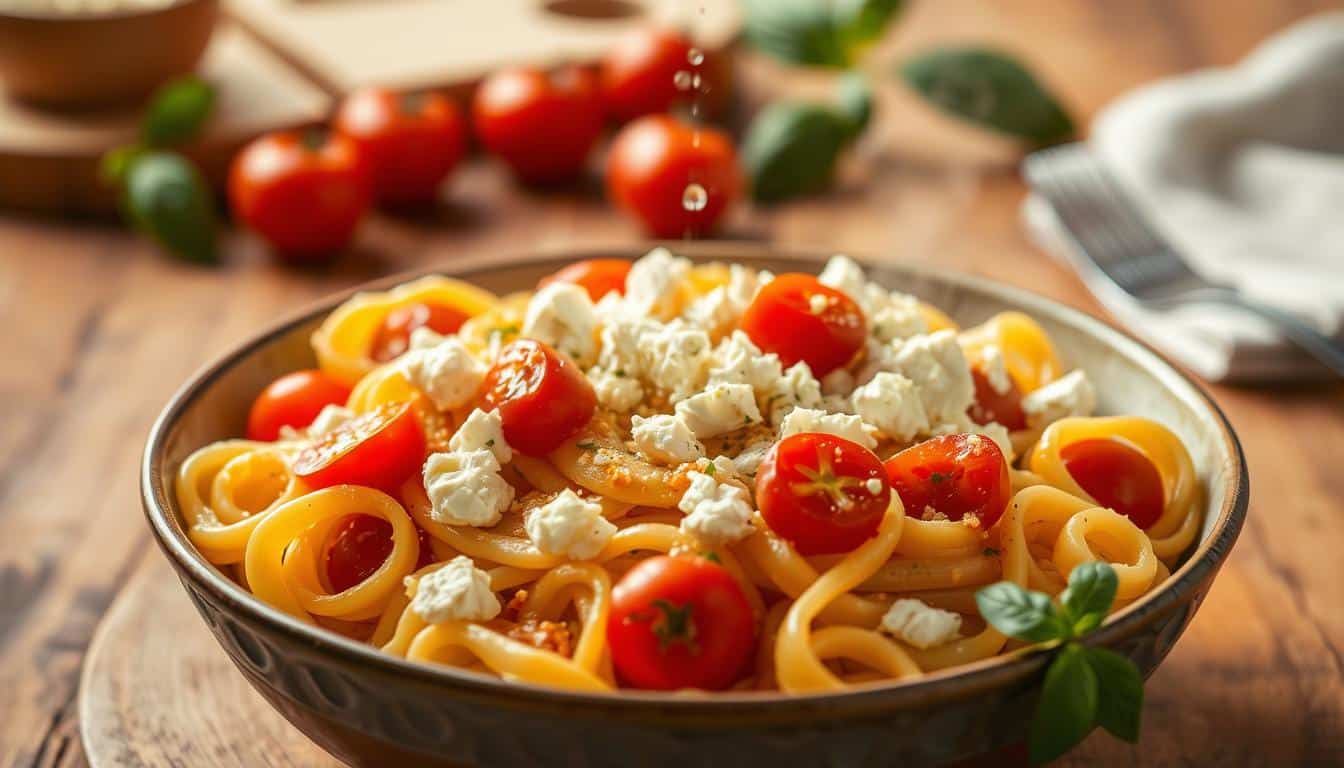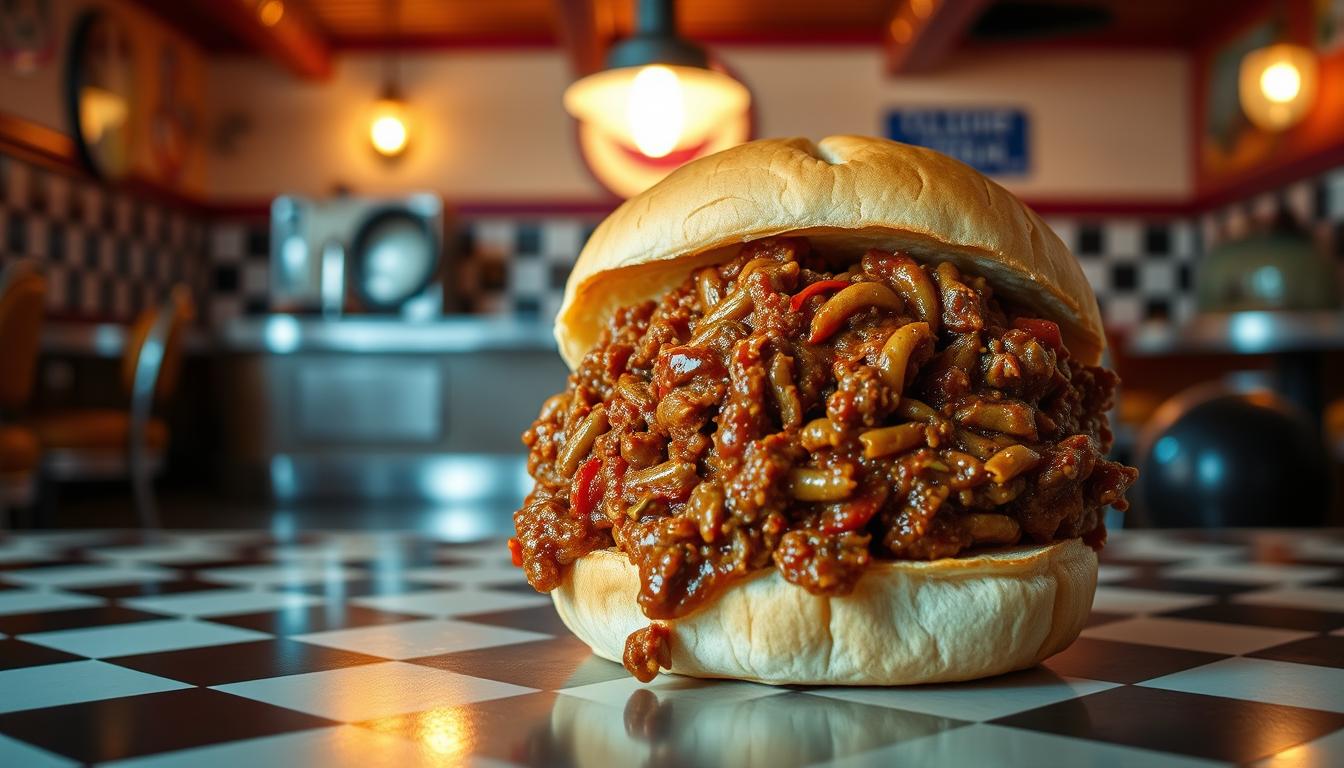Spaghetti and meatballs were more than just food in our busy Italian-American kitchen growing up. They were a tradition that brought families together. Every Sunday, our home would fill with the smell of tomato sauce and meatballs. These moments created memories that lasted forever.
Making the best spaghetti and meatballs is an art. It combines passion, technique, and love. This classic dish is not just about following a recipe. It’s about creating a meal that warms your heart and fills your soul.
Whether you’re new to cooking or have years of experience, this guide will help you. You’ll learn how to make delicious spaghetti and meatballs. It’s like stepping into a traditional Italian kitchen.
Key Takeaways
- Master the art of authentic Italian-American cuisine
- Learn professional techniques for perfect meatballs
- Understand the importance of quality ingredients
- Discover secrets to creating rich, flavorful sauce
- Transform your home cooking with traditional methods
Essential Ingredients for Classic Italian-American Comfort Food
Starting with the right ingredients is key to making great spaghetti and meatballs. It’s about choosing the best to make your meal unforgettable.
Quality Ground Meat Selection
Choosing the right ground beef is crucial for tender, flavorful meatballs. Chefs suggest mixing meats for the best taste and texture. Here are some options:
- 80/20 ground beef for optimal fat content
- Blend of ground beef and ground pork
- Mixed meat combination (beef, pork, veal)
Fresh Herbs and Aromatics
Italian herbs are essential for enhancing meatball flavor. Using fresh ingredients makes a big difference:
- Basil – adds bright, aromatic notes
- Fresh parsley for vibrant green color
- Minced garlic for depth of flavor
- Dried oregano for traditional Italian seasoning
Pasta and Sauce Components
Choosing the right pasta and sauce is crucial for your dish. Opt for high-quality, traditional items:
- Semolina wheat pasta for authentic texture
- San Marzano tomatoes for rich sauce base
- Extra virgin olive oil
- Freshly grated Parmigiano-Reggiano cheese
By picking each ingredient with care, you’ll make a spaghetti and meatballs dish that’s as good as those in Italian-American restaurants.
Kitchen Tools and Equipment You’ll Need
Creating the perfect spaghetti and meatballs is more than just using great ingredients. Your cooking tools are key to a tasty meal. The right kitchen gear can turn a good dish into an amazing one.
Begin with the basic cooking tools that make prep easier. A big pasta pot is essential for cooking spaghetti just right. Choose a pot with a heavy bottom and enough room for the pasta to cook well.
- Mixing bowls: Pick sturdy, large mixing bowls for mixing meatball ingredients
- Heavy-bottomed saucepan for making tomato sauce
- Sharp chef’s knife for cutting ingredients accurately
- Meat grinder or food processor for a smooth meatball mix
Your mixing bowls should be big enough to mix without spills. Stainless steel or ceramic bowls are best for keeping temperature and easy cleaning.
Invest in top-notch cooking tools for more than just this recipe. A wooden spoon, meat thermometer, and strong colander will make cooking better.
Perfecting Your Homemade Meatball Recipe
Making the perfect meatball recipe takes skill and precision. It’s all about understanding the key elements that turn simple ground meat into a dish to remember.
Mixing and Seasoning Techniques
The secret to great meatballs is gentle mixing. Don’t overwork the meat, as it can make the meatballs tough. Use your hands to mix the ingredients, just until they’re evenly spread. Seasoning is an art that needs balance.
- Use fresh herbs like parsley and basil
- Add grated Parmesan cheese for depth
- Include minced garlic for robust flavor
- Season with salt and black pepper
Size and Shape Guidelines
The size of your meatballs affects cooking time and texture. Keeping them all the same size ensures they cook evenly. Aim for meatballs that are 1-1.5 inches in diameter. This size gives you a crispy outside and a juicy inside.
Common Meatball Mistakes to Avoid
Stay away from these common mistakes to avoid disappointment:
- Avoid using lean meat only – mix in some fatty ground beef
- Don’t skip the breadcrumbs – they help retain moisture
- Never compress meatballs too tightly
- Resist the urge to move meatballs constantly while cooking
Mastering these techniques will help you make meatballs that are tender, flavorful, and sure to impress at your next meal.
Crafting the Perfect Tomato Sauce
Making an authentic Italian sauce recipe begins with picking the right ingredients. Your homemade tomato sauce can turn a simple meal into a masterpiece. The key is understanding the sauce-making process.
For a top-notch homemade tomato sauce, focus on a few important things:
- Choose high-quality San Marzano tomatoes for the richest flavor
- Use fresh garlic and basil for authentic Italian taste
- Select extra virgin olive oil for depth and richness
Your Italian sauce recipe starts with preparation. Begin by sautéing minced garlic in olive oil until it’s fragrant but not browned. This step creates a flavor base that enhances the sauce.
When adding tomatoes, crush them by hand to release their sweetness. Let the sauce simmer slowly. This low, slow cooking breaks down the tomatoes, making the sauce smooth and rich.
Seasoning is key in your homemade tomato sauce. A pinch of salt, fresh basil, and a bit of black pepper can make a simple sauce amazing. Remember, less is more when making an authentic Italian sauce.
- Cook for 45-60 minutes for optimal flavor development
- Stir occasionally to prevent sticking
- Taste and adjust seasonings as needed
Your perfect homemade tomato sauce is now ready. It’s perfect for your spaghetti and meatballs, adding a touch of Italian tradition to your meal.
Mastering Authentic Spaghetti and Meatballs
Cooking spaghetti and meatballs is an art that needs precision and passion. The secret to a true Italian-American dish is knowing the detailed techniques. These techniques turn simple ingredients into a culinary masterpiece.
Traditional Cooking Methods for Meatballs
Traditional methods can make your dish go from good to great. Begin by browning the meatballs in a hot skillet. This creates a beautiful caramelized exterior that keeps flavors locked in.
This step is key for rich, deep tastes that will stand out in your dish.
- Pan-fry meatballs until golden brown on all sides
- Avoid overcrowding the pan to ensure even cooking
- Use a cast-iron skillet for best results
Temperature and Timing Secrets
Getting the right temperature is crucial for perfect spaghetti and meatballs. For simmering sauce, keep the heat gentle. This lets flavors blend without burning. Meatballs should cook slowly to stay tender and juicy.
| Cooking Stage | Recommended Temperature | Cooking Time |
|---|---|---|
| Browning Meatballs | Medium-High (375°F) | 3-4 minutes per side |
| Simmering in Sauce | Low (200-250°F) | 25-30 minutes |
Combining Pasta and Sauce Perfectly
The magic happens when you mix pasta and sauce. Always finish your pasta in the sauce for the best flavor. Drain the pasta when it’s al dente. Save some pasta water to help the sauce stick to each strand.
Pro tip: Toss the pasta in the simmering sauce for 1-2 minutes before serving. This makes sure every bite is full of rich, robust flavors. It’s like being in an Italian kitchen.
Al Dente Pasta Cooking Guidelines
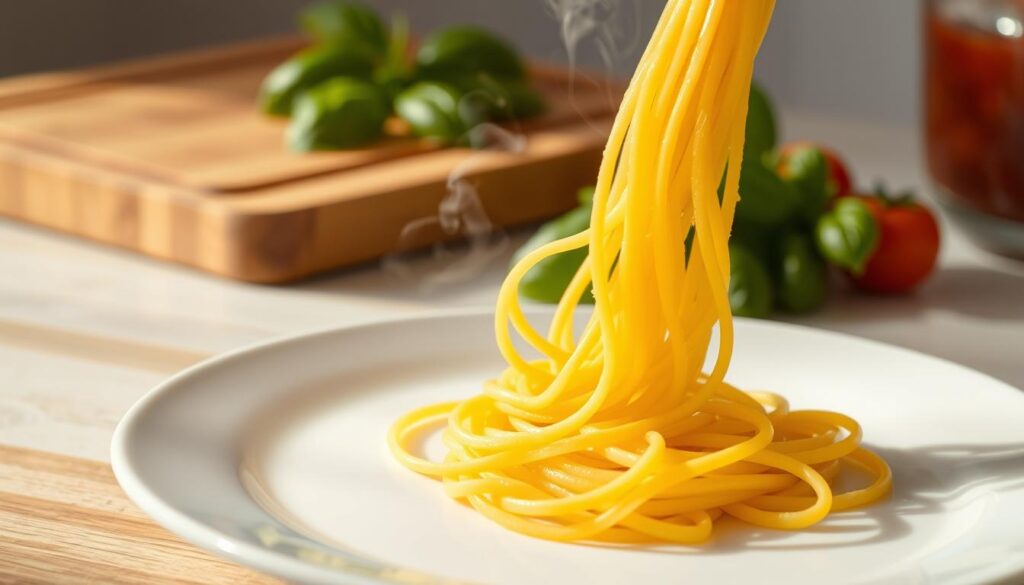
Cooking pasta to perfection is an art that every home chef should master. Al dente spaghetti requires precision and attention to detail. The term “al dente” means “to the tooth” in Italian, describing pasta that is cooked to be firm when bitten.
To achieve the perfect al dente texture when cooking pasta, follow these essential guidelines:
- Use a large pot with plenty of water (at least 4-6 quarts)
- Add 1-2 tablespoons of salt to enhance flavor
- Bring water to a rolling boil before adding pasta
- Stir occasionally to prevent sticking
Timing is crucial in cooking pasta. Different pasta shapes require varied cooking times. Here’s a quick reference guide for common pasta types:
| Pasta Type | Typical Cooking Time | Al Dente Indicator |
|---|---|---|
| Spaghetti | 8-10 minutes | Slight resistance when biting |
| Linguine | 7-9 minutes | Firm but not crunchy |
| Penne | 10-12 minutes | White dot in center when cut |
The ultimate test for al dente spaghetti is simple: remove a piece of pasta and bite into it. It should have a slight resistance in the center while being fully cooked. Pro tip: Always save a cup of pasta water before draining. This starchy liquid can help create a perfect sauce consistency.
Avoid common mistakes like overcooking or rinsing your pasta. Drain immediately and toss with sauce right away to lock in that perfect al dente texture.
Professional Tips for Tender, Juicy Meatballs
Making juicy meatballs takes skill and precision. Professional chefs use special techniques to make ground meat into delicious bites. The trick is to keep moisture in and get the right texture.
To start, pick your ingredients carefully. Your meat mix should have the right fat and lean protein for flavor and moisture.
Moisture Retention Secrets
There are a few key steps for juicy meatballs:
- Use milk-soaked breadcrumbs to add moisture
- Choose ground meat with 15-20% fat content
- Avoid overworking the meat mixture
- Add an egg to bind without making it tough
Proper Browning Methods
Browning is key for deep flavor in your meatballs. Different methods can help you get the perfect outside:
- Pan-frying for crispy golden edges
- Oven-baking for even heat
- Gentle simmering in sauce for tenderness
Professional chefs say mixing techniques is best. It makes meatballs crispy on the outside and juicy inside. Try these methods to improve your cooking.
Sauce and Pasta Pairing Techniques
Mastering pasta sauce pairing is key to a great spaghetti and meatballs dish. The right sauce ratio can turn a simple meal into a masterpiece.
When picking your sauce, think about these important points for the best pasta coating:
- Sauce viscosity impacts overall dish quality
- Pasta shape determines sauce adherence
- Meatball size influences sauce distribution
Getting the right spaghetti sauce ratio is all about technique. You want each pasta strand to be coated just right, not soggy. Chefs suggest using pasta water to adjust the sauce’s consistency for a smooth texture.
| Pasta Type | Recommended Sauce Ratio | Best Meatball Pairing |
|---|---|---|
| Spaghetti | 1/2 cup sauce per serving | Medium-sized beef meatballs |
| Linguine | 3/4 cup sauce per serving | Smaller, more delicate meatballs |
| Fettuccine | 1/3 cup sauce per serving | Large, robust meatballs |
Pro tip: Always save some pasta cooking water. This starchy liquid helps bind sauce to pasta, making the dish more cohesive and flavorful.
Try different sauce-to-pasta ratios to find your ideal mix. Aim for a balance where neither sauce nor pasta overpowers the other.
Serving and Presentation Suggestions
Turning spaghetti and meatballs into a memorable meal is all about how you present it. Masterful plating and thoughtful garnishing can make your dish stand out. It becomes a feast for the eyes and taste buds.
Presentation is more than just putting food on a plate. It’s about creating a dish that looks as good as it tastes. Your goal is to make it visually appealing.
Garnishing Options
Here are some elegant ways to garnish your dish:
- Sprinkle fresh basil leaves for vibrant color
- Dust with freshly grated Parmesan cheese
- Drizzle high-quality extra virgin olive oil
- Add red pepper flakes for a touch of heat
Plating Techniques
Professional plating needs attention to detail and technique. Here are some strategies to enhance your spaghetti and meatballs:
| Technique | Description |
|---|---|
| Twirling Method | Use a large fork to create elegant pasta spirals |
| Meatball Placement | Arrange meatballs strategically around or on top of pasta |
| Sauce Distribution | Lightly coat pasta, ensuring even coverage |
Serve on warmed plates for a restaurant-quality feel. Remember, we eat with our eyes first. Take time to arrange your dish beautifully. It will impress your guests.
Storage and Leftover Tips
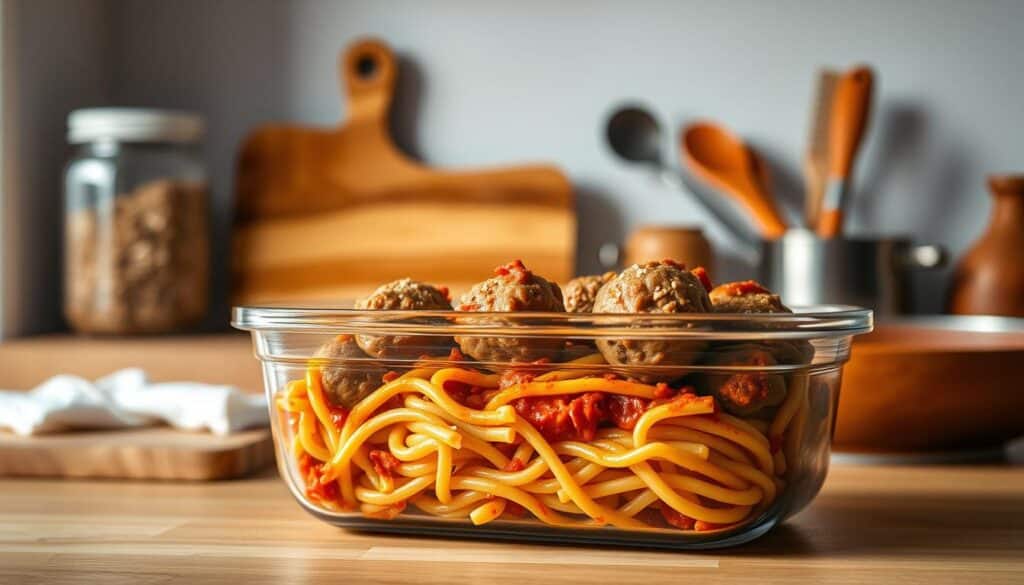
Keeping the taste of spaghetti and meatballs alive is all about smart storage. Your meal can stay fresh and flavorful with the right methods.
For the best results, follow these tips:
- Separate pasta and meatballs before refrigeration
- Use airtight containers to keep it fresh
- Store it in the fridge within two hours of cooking
Reheating meatballs needs care to avoid drying them out. Experts say gentle reheating helps keep moisture and flavor.
Here are some ways to reheat meatballs:
- Microwave with a damp paper towel on top
- Warm in a skillet with a bit of marinara sauce
- Oven method: Cover with foil and heat at 350°F for 10-15 minutes
Turning leftovers into new dishes is fun. Try meatball sandwiches, pasta frittatas, or add them to salads for a twist.
Pro tip: Stored right, your spaghetti and meatballs can last 3-4 days in the fridge. Always check for spoilage before reheating and eating.
Conclusion
Making the perfect spaghetti and meatballs is more than just following a recipe. It’s about diving into the heart of homemade Italian cuisine. You’ve learned techniques that turn simple ingredients into a memorable meal.
Every dish has a story, and your spaghetti and meatballs will tell yours. You’ve picked the best ingredients and mastered cooking. Now, your kitchen is your canvas, and these skills are your brushes.
We urge you to try new things, make the recipe your own, and share it with others. Cooking is a journey of learning, and every meal is a chance to get better. Don’t be afraid to add your own twist.
Your journey in homemade Italian cuisine is just starting. Enjoy the process, savor each bite, and remember. The best recipes come from love, patience, and a desire to explore.
